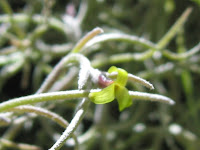Flowering Spanish Moss

The grey, wispy Spanish Moss (Tillandsia usneoides) is a kind of bromeliad, and bromeliads have some of the largest flowering structures of any plant (the biggest is the rare Bolivian bromeliad, Puya raimondii, with a flower cluster over 2 m wide and 10 m high – that’s a large truck on its end!). Spanish Moss however has tiny leaves, and equally tiny flowers. Now is the time of year to look for the flowers in Sydney. They are very pretty, if petite. Their bright green colour is quite striking against the dull grey of the tangled mass, once you look carefully.
You will be aware that like most bromeliads Spanish Moss doesn’t develop roots and takes up water and nutrients directly from the surface of the leaves, in this case assisted by special modified hairs. Although Spanish Moss is widely cultivated in gardens it appears to be becoming naturalised in Australia such as the Central Coast and further north. It's dispersed by birds in its native range in middle America – they use it as nesting material - and if Australian birds discover this use in a big way it could become a major environmental weed.
The story of how this bromeliad got its genus name is intriguing. It’s named in honor of a Swedish botanist who was a professor in Scandinavia in the 1600s. As a student, Elias Tillander, was so seasick when he crossed directly from Stockholm to Finland, that he returned to Stockholm by walking more than 1,000 miles around the Gulf by land. As a result he adjusted his name to Tillanda, meaning ‘by land’ in Swedish. Fellow Swede, the famous Carl Linnaeaus named the genus after Tillander because it seemed that Spanish Moss also didn’t like water.
The species name refers to the similarity of this plant to the lichen Usnea (Old Man's Beard).
Comments